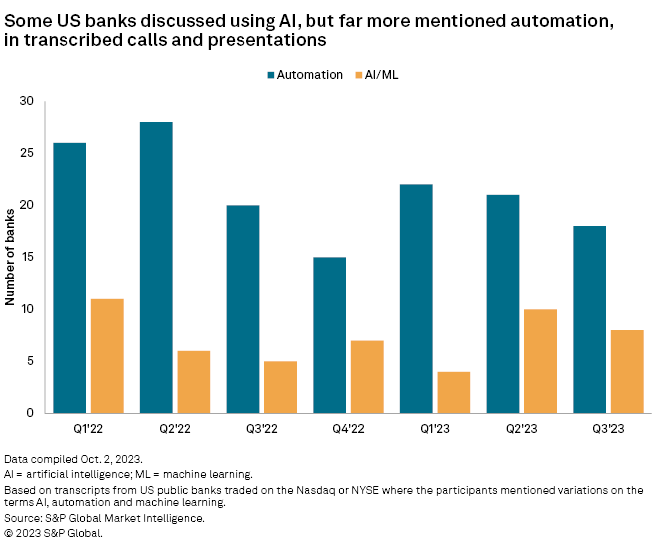The largest US banks mention AI frequently during conference calls and company presentations, often emphasizing how it has improved internal efficiency and delivery systems for customers. But they are not the only ones. Several community banks have discussed using AI as well, based on our review of transcripts since the start of 2022, and we expect more to follow.

The banking industry was an active user of AI even before the deluge of mainstream interest created by ChatGPT. It has been applied to a variety of tasks at banks, including loan approvals and know-your-customer checks. Banking is an ideal industry for adoption, in our view, as it has made great strides to offer online versions of transactions that were previously done on paper or in person. We think banks will continue to seize on the latest AI advancements, including generative AI services like ChatGPT. Generative AI should enhance banks' chatbots greatly, but it can also be used for many other purposes throughout the organization, like software development and document drafting.
While AI investments require upfront spend, they could allow banks to become more efficient over time and, at the very least, could lead to a faster and better experience for customers. JPMorgan Chase & Co. estimated in May that leveraging AI and machine learning models across the organization on initiatives like fraud and personalization generated more than $500 million in value. But it is often difficult to isolate the precise financial impact based on a bank's reported earnings alone.

Eight publicly traded banks mentioned using AI and/or machine learning during conference calls and company presentations in the third quarter of 2023, based on an analysis using S&P Global Market Intelligence's transcripts database. While ChatGPT has likely created more interest of late, a look at the first quarter of 2022 — way ahead of ChatGPT's launch that November — shows even more banks mentioning the topic.

For context, only about 8% of the 338 US banks traded on the major US exchanges mentioned using AI and/or machine learning from the start of 2022 through the third quarter of 2023, according to our analysis. But the ones that did accounted for 80% of the total assets of all major-exchange-traded US banks since many of the largest institutions have embraced the technology.
That said, we do not know for sure how great industry adoption is; it is possible that the other banks are using AI and machine learning but did not mention it in transcripts. Many more used the term "automation" over the same time period, with 80 distinct banks mentioning the concept, per our tally. Those efforts might involve elements of AI and machine learning as well.
The largest US banks — JPMorgan, Bank of America Corp., Citigroup Inc. and Wells Fargo & Co. — use AI in myriad ways. Some of the most common themes, based on our transcript analysis, were cybersecurity, fraud detection and virtual assistants. But those were just a few examples. JPMorgan said at its investor day in May it had more than 300 AI use cases in production; for instance, its asset management division uses AI to develop trading strategies and hedge equity portfolios.
Much smaller banks are using the technology too. FVCBankcorp Inc. and Financial Institutions Inc. mentioned using AI in the decision-making process for loans. FVCBankcorp, whose Fairfax, Va.-based FVCbank had $2.34 billion in assets as of June 30, has an AI-driven small business lending platform known as Lightning Lending. The bank says approved applicants typically receive funds within 48 hours, with algorithms configured to automatically accept or decline each application. Financial Institutions, whose Warsaw, NY-based Five Star Bank had $6.1 billion in assets as of June 30, uses AI for credit decisions in its indirect auto lending business.
Even if a bank does not use AI for decision-making, it can be used to speed up the lending process. Live Oak Bancshares Inc., whose Wilmington, NC-based Live Oak Banking Co. had $10.72 billion in assets as of June 30, talked in the first quarter of 2022 about how Able AI Inc., a company it invested in, would help it ingest and classify commercial loan documents more quickly.
As those examples show, financial technology vendors have helped level the playing field for smaller banks. FVCBankcorp partnered with Numerated Growth Technologies Inc., a lending tech provider incubated by Eastern Bank, to create its platform, and Financial Institutions partnered with ZestFinance Inc., a company founded in 2009 that does business as Zest AI. Numerated has also worked with larger institutions, like First Horizon Corp., and Zest AI counts Discover Financial Services among its customers.
Banks both big and small talk often about how AI enhances customer service. In addition to making chat bots more intelligent, AI has helped human employees provide better next-best-action recommendations, resolve issues and perform complicated tasks faster. One of the more interesting developments, in our opinion, is how banks can use their customer-facing tools internally. Bank of America's Erica is used by bankers to query information about commercial clients, and Regions Financial Corp. uses its Regions Client IQ (RCLIQ) tool to predict client stress.
While the use of AI is within the grasp of smaller institutions, the development of the technology is a different story. Since the start of 2022, patents filed by banks where the abstract mentioned AI or machine learning was dominated by institutions with more than $100 billion in assets, based on data from IPQwery. The patent data revealed many of the same use cases as the call transcripts, with fraud detection and cybersecurity both popular topics. But a key difference we saw was the number of patents devoted to helping developers, including software testing, server maintenance and code repository management. Those use cases were not mentioned nearly as much in conference calls and company presentations.
This article was published by S&P Global Market Intelligence and not by S&P Global Ratings, which is a separately managed division of S&P Global.



